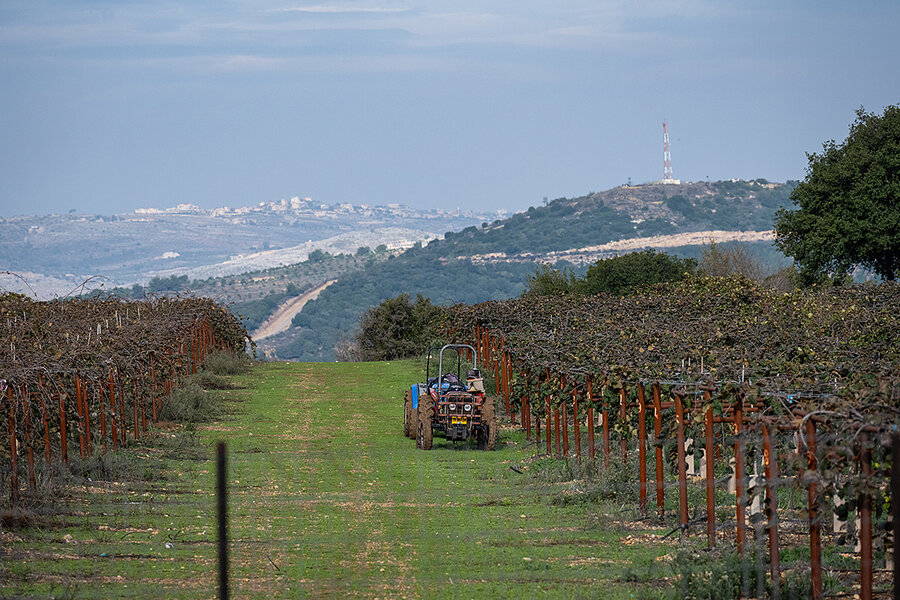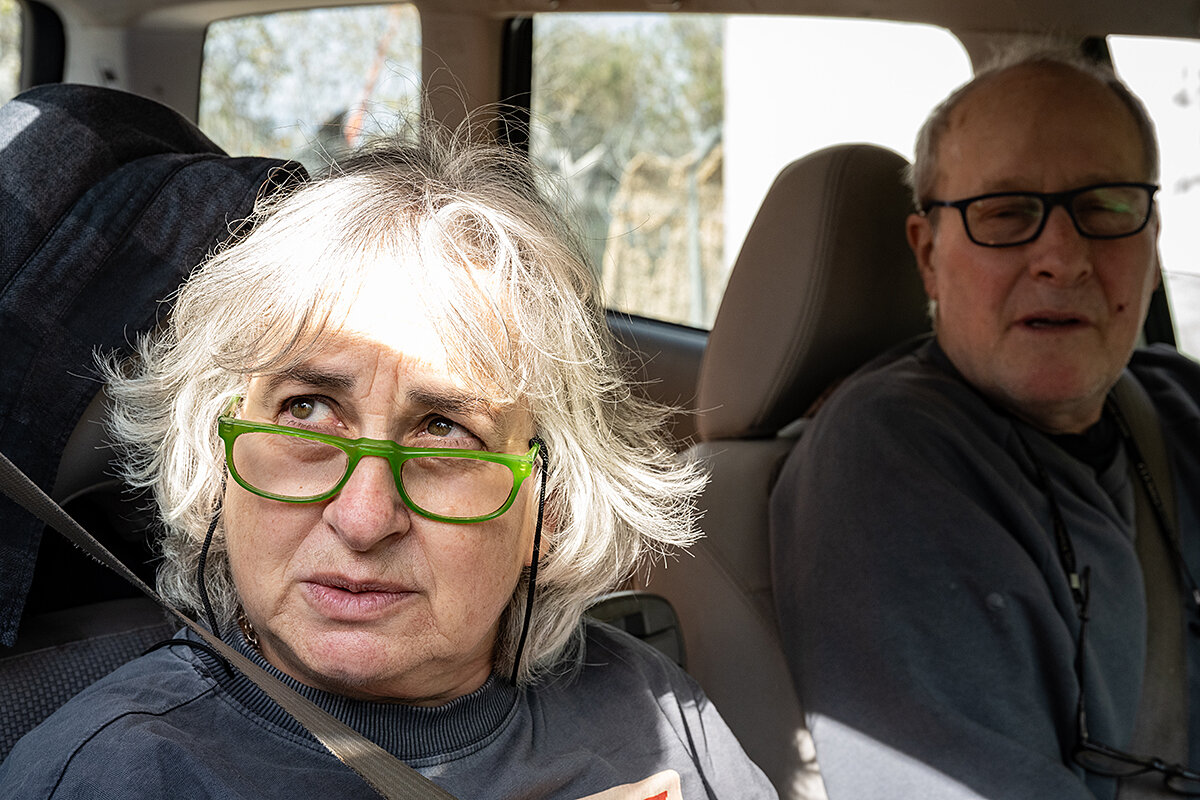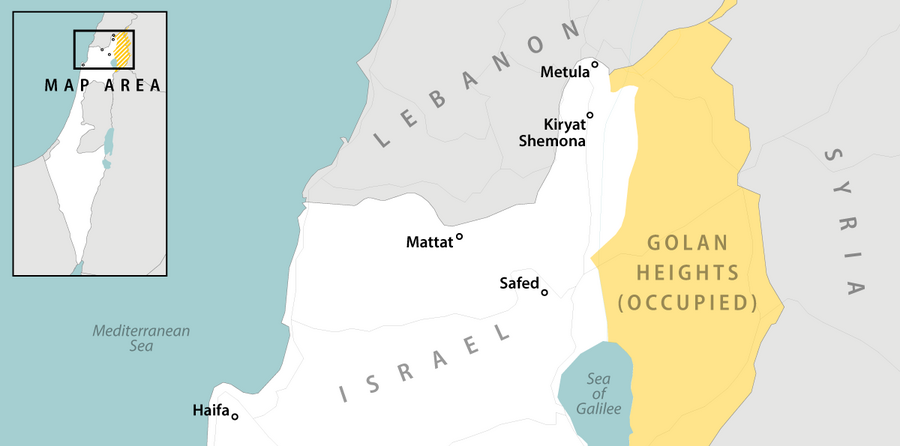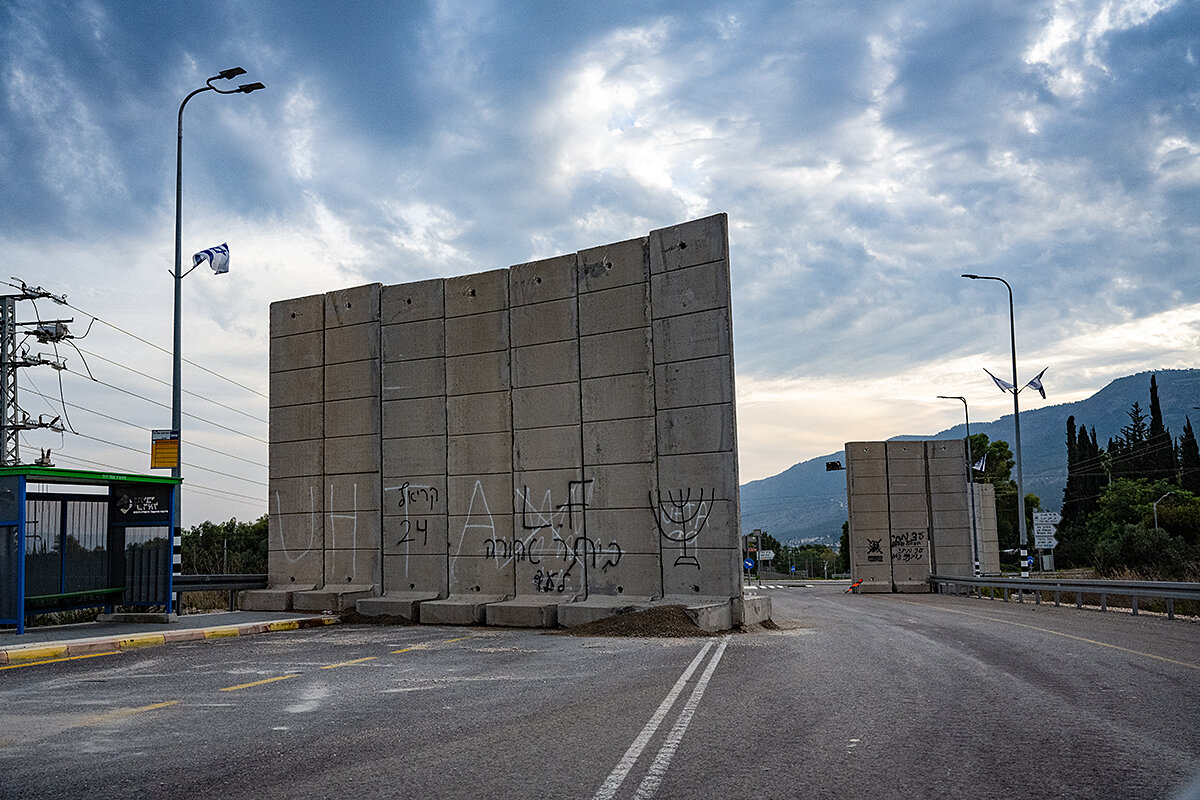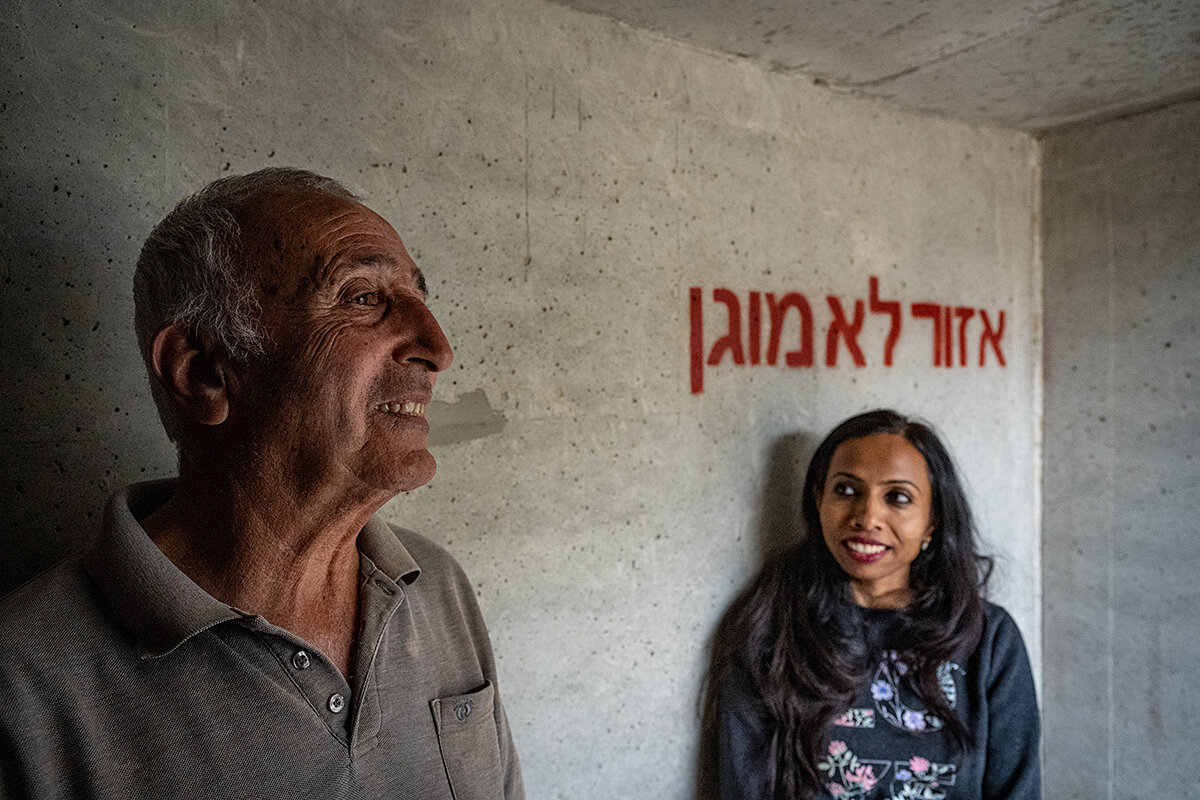Gaza echoes on Israel-Lebanon border: ‘It’s dangerous here’
Loading...
| MATTAT, Israel
Mira Telem was on a brief visit back to Mattat, a community of 60 families on the border with Lebanon, when she felt the impact of a missile that killed a farmer harvesting apples.
“All the house was shaking; it was close,” Ms. Telem says of the blast. “Every day we hear the bombs. Every day we hear everything.”
Why We Wrote This
A story focused onOct. 7 was a warning to Israelis in the north. The same kind of attack could happen there, with Hezbollah militants across the border. Many say they won’t feel safe until Israel deals with the threat. Others wonder why residents across the border can’t see each other as neighbors.
Mattat is one of dozens of communities in Israel’s north that were evacuated after daily exchanges of fire erupted across the border after Hamas’ Oct. 7 ground attack in the south, which left 1,200 people dead and 240 taken hostage.
For many who live here, cheek-by-jowl with Israel’s northern archfoe Hezbollah, the lesson of the Hamas attack is that Hezbollah must also be neutralized as a threat, before tens of thousands of Israelis can safely return to their homes in the evacuation zone.
“We say that something has to be done, after [Israeli forces] finish in the south,” says Ms. Telem’s son Aviv, a bearded reserve soldier who was born and raised in Mattat. “We cannot come back to live here,” he says, stepping behind a concrete barrier for protection. “We don’t know if in two years [Hezbollah] will do the same here in the north. This is what we are afraid of.”
The farmer was harvesting apples on a north-facing slope along Israel’s border with Lebanon when he was killed by a guided anti-tank missile fired by fighters of the Shiite militia Hezbollah.
Local residents say Eyal Ozen should not have been in the orchard near Mattat Thursday afternoon. The tiny Israeli community is one of dozens perched on the Israel-Lebanon border that were evacuated to avoid a possible repeat by Hezbollah, in the north, of Hamas’ Oct. 7 ground incursion in the south, which left 1,200 people dead and 240 taken hostage.
Israeli forces targeted the “source of fire” on the Lebanon side with attack helicopters and tank and artillery rounds. For those who live here, cheek-by-jowl with Israel’s northern archfoe Hezbollah, the killing was just the latest episode in a series of escalating daily tit-for-tat exchanges.
Why We Wrote This
A story focused onOct. 7 was a warning to Israelis in the north. The same kind of attack could happen there, with Hezbollah militants across the border. Many say they won’t feel safe until Israel deals with the threat. Others wonder why residents across the border can’t see each other as neighbors.
“It’s dangerous here,” says Mira Telem, who was on a brief visit back to her village community of 60 families when she felt the impact of the missile that killed Mr. Ozen.
“All the house was shaking; it was close,” Ms. Telem says of the blast. “Every day we hear the bombs. Every day we hear everything.”
Hezbollah reportedly said one of the 11 attacks it conducted Thursday targeted an Israeli barracks in Mattat, where the residential fence is a few hundred yards from Lebanon, and attendant fields go right to the border.
The hilltop road that leads to Mattat is especially vulnerable and visible to Lebanon, so two tall concrete barriers have been placed to block a direct view of the community gate. A new red sign in Hebrew warns: “Caution Danger!! You are about to enter a red route that is observable from Lebanon. Please drive on an alternative route!”
Hamas’ attack Oct. 7 resonates strongly here on Israel’s northern border. Hezbollah, an ally of Hamas and the most powerful wing of the Iran-backed “Axis of Resistance” against Israel and the United States, is renowned to be a much stronger foe. Its capabilities were battle-hardened in Syria’s civil war, and it possesses a missile arsenal estimated at 150,000-strong.
Indeed, the lesson of the Hamas attack for some here is that Hezbollah must also be neutralized as a threat, before tens of thousands of Israelis can safely return to their homes in the evacuation zone. Israeli forces ordered to “destroy” Hamas in Gaza have fought for two months, with a death toll of 18,000 Palestinians, according to the Hamas-run health ministry.
“We say that something has to be done, after [Israeli forces] finish in the south,” says Aviv Telem, a bearded Israeli reserve soldier with an assault rifle slung over his shoulder. The son of Mira and Yuval Telem, he was born and raised in Mattat.
“We cannot come back to live here, if nothing happens here in the north,” says Mr. Telem, stepping behind the concrete barrier on the road at the entrance to Mattat, to avoid giving an easy target to Hezbollah. “If nothing happens, we don’t know if in two years [Hezbollah] will do the same here in the north. This is what we are afraid of.”
He notes that United Nations resolutions that codified the cease-fire between Hezbollah and Israel, after a devastating 33-day war in 2006, meant that Hezbollah fighters were supposed to keep back from the border.
“It has not happened. We see them on the border. We see them with flags. We see them everywhere,” the reservist says. “Hezbollah is 10 times bigger than Hamas, so we are a lot more afraid about what can happen here. They have a lot more efficient weapons, missiles, more [precise] missiles. ... They can target anything they want.”
That concern has been echoed among the top brass in the Israel Defense Forces, and some Israeli officials have argued that Hezbollah should be targeted simultaneously with Hamas, rather than risk Hezbollah mounting its own offensive.
Lt. Gen. Herzi Halevi, the IDF chief of staff, visited troops on the northern border over the weekend.
“Both in the south and in the north, we need to return to a different situation, and return both security and a sense of security,” he reportedly told the 91st Division. “The State of Israel has never said war is the first solution to try, but we understand that with the situation here [in the north], it should end in a very, very clear change of situation.”
Prime Minister Benjamin Netanyahu, who has been under pressure to resign over Oct. 7, the most lethal day for Israelis since the founding of the Jewish state 75 years ago, also visited troops.
“If Hezbollah chooses to start an all-out war, then it will, by its own hand, turn Beirut and southern Lebanon, not far from here, into Gaza and Khan Yunis,” he warned.
Over the weekend, Hezbollah continued drone and rocket attacks against IDF and civilian targets, prompting a wave of Israeli airstrikes in southern Lebanon. Four Israeli civilians and six Israeli soldiers have been killed overall on the northern front during the war, while an Agence France-Presse tally counts more than 120 dead in Lebanon – among them 98 Hezbollah members, 16 Palestinian militants, and three journalists.
Maps of Israeli and Hezbollah strikes against each other since Oct. 7 span the entire breadth of the border. Near the eastern end is Metula, at the tip of a finger of land pointing northward and surrounded by Lebanese territory on three sides.
Not all have heeded the mandatory evacuation orders, including Arie Almog, who has lived the last 40 of his 74 years in Metula. Israeli soldiers at dusk Friday temporarily prevented him and his partner, Imy George, from entering town – they pointed to their house from the checkpoint – as alarms sounded of another Hezbollah rocket attack.
Indeed, just down the road 15 minutes earlier, a Hezbollah rocket could be heard flying overhead before impact.
“We as the third generation in Israel, for us it is very difficult to accept to leave our houses and villages,” Mr. Almog says after being ushered by soldiers into a concrete shelter. He reckons that 10 people – the soldiers say 50 – remain in Metula, out of a prewar population of 2,000.
“Of course, you don’t want your children to hear the bombs around here,” he says. “You don’t want to feel that maybe [Hezbollah] will attack, and go inside the villages and do what [Hamas] did from the Gaza Strip.”
The older generation is more inclined to stay, which is something that can’t be explained “to a boy like that,” says Mr. Almog, nodding toward a soldier who had just confirmed evacuation orders.
“What we built in this country didn’t come just like that, if for every bomb ... we are going to escape and run away like a chicken,” he says.
Back at Mattat, even as Ms. Telem jokes that she and her husband, Yuval, a blacksmith, are “running away” because of the risks – their car is packed – there is a moment of reflection about Lebanese villages right across the border.
“Usually in peaceful days, I always ... tell myself, ‘Why can’t people just live in peace?’” she asks. “Because it’s so close, we could go to visit them [the Lebanese], to stay with them, to sit with them and drink coffee and talk with them. They could come over here.
“What is the matter with them? Or, what is the matter with us? Why do we have to fight all the time?” adds Ms. Telem. “It’s so obvious that we can go and visit the neighbors, as we visit here the neighbors.”
Mr. Telem says he was a young soldier who fought in the Golan Heights in 1973, when Israel was shocked by a surprise attack by Syria and Egypt. Back then, he said, there was not even a fence along this border.
“We were shocked in ’73, and we are shocked now. I hope after 50 years, maybe people try to do it better, because the system is bad for everybody,” says Mr. Telem. “I am not a genius. I have no plan for how to do it better. But I hope that after two unbelievable fights, that something will change.”




